Leveque’s talk about sex
March 8, 2010 by Mitch Thompson · Leave a Comment

Hayley Leveque, a fourth-year psychology student, stands at the entrance to the room where she interviews her subjects. Leveque said her field of study, sexual psychology, is uncommon due to its taboo nature. (Mitch Thompson photo)
Hayley Leveque wants to talk to you about sex.
A fourth-year psychology student, Leveque is in her final semester of the honours program, which requires students to develop and run a research experiment.
For her project, Leveque is polling couples between the ages of 18 and 25, and those over 30, on their relationships, and seeing how the two compare.
Her inspiration came from her friends and the various issues in their relationships.
“I was getting anecdotes and stories from friends where they were having difficulty staying together or figuring out the status of their relationships,” she said.
Some friends had also started experimenting with casual sex, and it got Leveque wondering why all these issues were occurring at these ages.
Her research is centred around the work of psychologist Jeffery Arnett, who, in 2000, wrote an article on a phase of life he labelled “emerging adulthood.”
Young people from 18 to 25, Arnett theorized, are free of the rules and regulations that held them in adolescence but have not yet reached the point where they have taken on the responsibilities of adulthood, such as careers or children.
During this time, emerging adults spend a lot of time thinking about the direction their lives will take, an extended period of self-discovery.
But Leveque hasn’t found a lot of research on the sexual relationships of this age group and how they differ from older people.
“If we can get a glance at some of the normative sexual behaviours of emerging adults as a group, we can start to figure out why these things are happening,” she said.
She hopes that her research will uncover the motivations behind young people’s relationships, the reasons why they are having sex. She sees her work as creating a better understanding about the nature of young adult relationships in general, a knowledge that Leveque feels could assist services such as couples counselling.
Leveque is still early on in her study, collecting interview subjects and compiling data. After that, she’ll analyze the data to see what makes emerging adults tick.
She can’t say what her hypothesis is or how many people have signed up (for fear of tainting the interview pool) but she did say that she’s looking for more people, especially those couples who are 30 or older, to talk about sex with her.
“Older adults are definitely harder to collect. They have kids to take care of and longer work hours,” she said.
Anyone interested in participating in the study can contact Hayley Leveque at 604-315-3931 or via email her.
Interactive: A visual guide to the KSA
February 8, 2010 by Mitch Thompson · Leave a Comment
Ever wondered what the KSA is all about? The following three interactive charts give you details about the various KSA positions, including duties and wages, as well as other information about how student government works at Kwantlen.
Charity event for Big Brothers will be a circus
January 15, 2010 by Mitch Thompson · Leave a Comment
Kwantlen’s second-year public relations students will be putting on a fund-raising event for Big Brothers of Greater Vancouver on Feb. 9.
The event, “Circus of the Night,” is a circus-themed benefit, featuring music, an illusionist and both a live and silent auction.
“We chose Big Brothers because it is a well-respected organized charity that is important to society,” said Natalie Burgwin, PR student and one of the events organizers.
Although the fundraiser is part of the student’s course work, they said that it’s not about grades.
“We’re not just doing it to pass a course,” said organizer Ashley Letts. The event and charity are something they really believe in, she said.
Tickets for the event are $40 and can be ordered through the PR department.
Believe it or not: The unexpected history of three Lower Mainland roads
January 14, 2010 by Mitch Thompson · Leave a Comment

Bill Purver, archivist for the City of Richmond, examines a statue of Minoru commissioned by the city to honour the popular racehorse.
An award-winning racehorse, a severed leg and a murderer are not typical inspirations for street names, unless you live in B.C.
Those three items are the basis of street names in Richmond, Surrey and Vancouver, and among the weirder stories collected by the cities’ archivists.
City archivists collect and record the histories of the various municipalities, and store it for later reference.
Melanie Hardbattle, an archivist with the City of Vancouver, said her job offers a necessary service to those in Vancouver.
“It’s very important for people to feel a connection to the past,†she said.
Many use the archival records to research city events, family lineage, even the history of their houses.
“We provide an important service to those people. If we didn’t have the records, we wouldn’t be able to provide that info,†she said.
Sometimes that provided info can get a little strange. Below are the three of the wildest stories behind street names.
Richmond – Minoru Boulevard
A quick Google Maps search for “Minoru†in Richmond gives about 500 results, covering one area of the map in little red dots. There’s Minoru Chapel, Minoru Place Senior’s Centre, Minoru Laser Dental, not to mention the actual boulevard itself. Minoru is everywhere.
“Most people think that Minoru is a Japanese name, and has something to do with the Japanese-Canadian community,†said Bill Purver, a Richmond archivist. Purver explained that many Japanese immigrants came to the Steveston area in the 1800s to seek out lives as fishermen.
But the popular name has absolutely nothing to do with the Japanese-Canadian community.
The boulevard et al are actually named after the thoroughbred horse Minoru, who, in 1909, was the first horse to win two classic races, the 2,000 Guineas and the Derby, while wearing a reigning monarch’s colours.
In August of that same year, construction on a Richmond racetrack finished. It was christened Minoru Park in honour of the record-holding horse.
The racetrack was a hit, with 7,000 spectators attending the first day, according to a Richmond News feature. The track closed in 1941, but the name’s popularity had spread, leading to the many things Minoru.
Surrey – Hall’s Prairie Way
It was once the best horse-and-carriage road south, with an infamous claim to fame.
Hall’s Prairie Way, now 184th Street, may be the only British Columbia street named for a murderer.
In 1845, Sam Hall and his First Nation’s wife were the first to settle the southeast Surrey district.
Soon after, Hall killed his wife. He later died in prison.
When the next wave of settlers came they called the place Hall’s Prairie, after the homicidal husband.
“Only a mouldering cabin and a legend remained,†wrote Fern Treleaven in his 1981 book Rivers, Roads and Railways.
He also wrote that the children of the new settlers feared the old Hall cabin, believing it to be haunted.
Vancouver – Leg-in-Boot Square
Since late 2007, B.C. residents have been living with a strange occurrence: severed feet washing up on shore.
These feet are unidentifiable and unclaimed, but also not a new thing. This has happened once before.
In 1887, local police found a knee-high boot, complete with severed leg, in the forests of False Creek.
The police placed the limb outside the station, hoping someone would claim it, according to Elizabeth Walker’s Street Names of Vancouver. No one did.
Stuart Cumberland, a 19th-century writer, mentions the boot in his 1887 book The Queen’s Highway.
“Just before I visited Vancouver, a man had mysteriously disappeared; and, on the day of my arrival, a top-boot, containing a foot and portion of the leg, had been found in the forest of False Creek. This, it was surmised, was all that remained of the missing man, a cougar having disposed of the rest.â€
The forested area is long gone, but the story lives on. In a 1976 act, the city named the False Creek location Leg-in-Boot Square.
Sidebar:
If you’re looking for a perfect Christmas present, why not get something truly original: a street named after the recipient. Vancouver’s street-naming committee receives about half-a-dozen letters a year from Vancouverites putting forward the names of relatives and major contributors to the city’s development.
Nominations run the gamut from someone’s great grandfather to the recently deceased Jack Poole, former VANOC president.
“We maintain a fairly extensive list of people who have been nominated,†said Marg Coulson, acting city clerk and chair of the committee. When a name comes before the panel, an archivist researches it, determining the nominee’s contributions to the city. “We really don’t want to be too restrictive, because people make contributions in different ways,†said Coulson.
When the merits of the name are proven, the name gets shortlisted. The list has just over 100 names on it, said Coulson.
If a street is created and a name required, the committee peruses the list to see which fits best, usually someone from the related area. A recommendation is then made to city council. The need for a name is rare, as Vancouver has very little in the way of new developments. The panel usually receives only one request a year.
“One thing I should say is that we do not consider people who are alive,†said Coulson, which could create a slight set-back for those considering self-nomination.
“We’ll have to kill you and then we can consider you,†she said, laughing.
Kwantlen University by the numbers: A calculated look at our school’s student demographics
January 14, 2010 by Mitch Thompson · Leave a Comment
By Jacob Zinn & Mitch Thompson
To better understand how the generational groups at Kwantlen work, the Chronicle polled a sample of students from three campuses: Surrey, Richmond and Langley.
The students were asked what year they were born, how many computers they own, if they have a Facebook page and whether or not they agreed with the generational values usually associated with people their age.
They were then given a five-point history quiz in which major events were named. Students had to give a basic description of 9/11, the Challenger shuttle disaster, JFK’s assassination, knowledge of the Berlin Wall and the bombing of Pearl Harbour.
The following graphs are the compiled results.

First music format purchase - Generation Y

First music format purchase - Generation Z
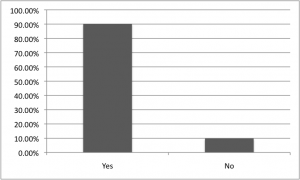
Facebook page - Generation Y

Facebook page - Generation Z
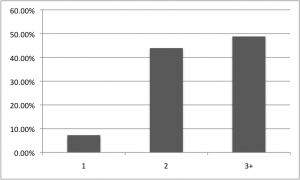
Number of computers owned - Generation Y
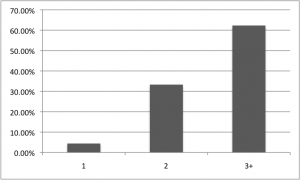
Number of computers owned - Generation Z

Agreement with generational characteristics - Generation Y
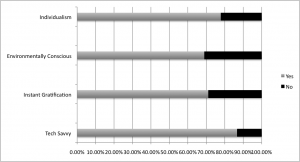
Agreement with generational characteristics - Generation Z

Percentage of correct answers to historical quiz - Generation Y
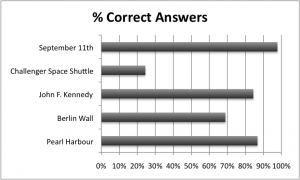
Percentage of correct answers to historical quiz - Generation Z
Students are learning more, but in danger of info overload
January 14, 2010 by Mitch Thompson · Leave a Comment

The overall population breakdown of Kwantlen Polytechnic University, based on age.
Almost half of Kwantlen students are members of Generations Y and Z, according to figures from the Institutional Analysis and Planning department, and were born into a world of personal computers and an explosion of information.
Generation Y includes people born between 1980 and 1989; Generation Z is those born in 1990 and subsequent years. Student records show that 48.8 per cent of Kwantlen students were born between 1988 and 1992.
The Y and Z designations came from a need for a distinction between the Baby Boomers, who were born after World War Two, and their children, who were born between 1965 and 1980. Those children have been called the “after-boomers.â€
Canadian author Douglas Coupland coined the phrase Generation X in his 1991 novel Generation X: Tales for an Accelerated Culture. He believed the title signified the seemingly contradictory ways of post baby-boom society.
The name caught on,and the Y and Z labels followed.
According to an article on About. com, a New York Times-run website, Gen-Yers value family time and teamwork. Generation Z, however, is more individualistic and puts less stock in family values, according to an article in Australia’s Herald Sun.
But there is one overarching value that the generations share.
“The main value, given their age, is probably a thirst for knowledge and looking for means of meaningful self-expression,†said Peter Clayton, a Kwantlen instructor whose courses focus on media and sociology.
This need to know manifests itself in the widespread use of the Internet to discover information and communicate ideas to others.
“The more serious-minded of them spend an enormous amount of time online in the quest for knowledge,†said Clayton.
The older ways of researching, using libraries and books, are slowly being phased out in favour of websites such as Wikipedia or Google.
It’s a change that allows them to learn while delivering the content in a way that is culturally relevant to them, explained Clayton.
However, this cultural inclination towards technology has created never-before-seen consequences for those of Generations Y and Z.
“The downside of all the information technology is that, as far as
leisure time is concerned, people spend more time on their own,†said Clayton.
Generations Y and Z are characterized by physical isolation.
Though they may be talking to friends online, they are still alone at a computer, which can have a negative effect on how they socialize in public.
“On one hand [their culture] encourages them to be more outward-looking,†said Clayton. “But on the other hand, it encourages them to be more isolated and inward-looking.â€
As well, constant access to the Internet has created two generations that suffer from information overload, Clayton said.
“They are probably a lot more stressed out than they realize,†he said. The two generations have become walking dichotomies, Clayton believes, as they want to learn as much as possible, but suffer from extreme information overload.
A thrift-store romance: How to impress the other gender when your budget is slender
January 13, 2010 by Mitch Thompson · Leave a Comment
The art of wooing can be expensive, especially for a poor university student, but creativity and a little pocket change can go a long way.
According to Sheree Morgan, a Vancouver-based professional matchmaker, the best place to start looking for value dates is away from screens or dinner tables.
“The best place for low-budget ideas is outdoors,†Morgan said.
With the large number of walking paths, hiking trails and parks in the Lower Mainland, there is something for all fitness levels.
Remembering your date’s physical prowess is important, as Soraya Raiszadeh, a Kwantlen student, knows well.
The thrifty outdoor excursion Raiszadeh went on included the infamous Grouse Grind.
“I wouldn’t say it was the best way to go on a date,†she joked.
Raiszadeh is one of 13 Kwantlen students asked by the Chronicle about the cheapest, most effective date they had been on. For the purpose of the poll, “effective†means that it lead to other dates, or was enjoyed by both parties.
Dana Stasyk, a first-year Public Relations student, was also courted outdoors. She was in Australia and, met a man named Pok, who took her for a stroll on the beach. “He had laid down a picnic at the end of the walk,†said Stasyk. “It was very sweet.â€
Romantic as woodland walks can be, Morgan does have one important tip. “Make sure you stick to the paths,†she cautioned. “It really kills the moment if you have to be rescued. Probably not a great way to end the date.â€
Going outside is one way that dates can be cost-efficient. The other involves a bit more inventiveness.
“Women love it if you’re a little bit creative,†said Morgan.
She used a past date she had been on to emphasize her point. “After a fresh snowfall, dress up really warm, take a thermos of hot chocolate and go to Stanley Park. I’d never done it before, and it’s probably one of the most wonderful things I’ve ever done,†she said. “It didn’t cost any money, it just took a little bit of thought.â€
Kaitlyn Cook, one of the interviewed Kwantlen students, also enjoyed a date that was simple, but memorable. Her date took her skating, but was absolutely awful at it. Luckily, Cook used to figure skate and they spent the date with her teaching him. “I don’t know, maybe he was faking, but it still made me feel special,†she said.
In fact, almost all of the students polled enjoyed the simple dates as much or more than the most expensive ones they had ever been on.
Ryan Cardoz, a business student, once took his date to Costco for hot dogs. The whole meal cost him a wallet-destroying $3.20.
“It was pretty effective,†Cardoz said. “We were both poor at the time.â€
The date was so good, he ranked it as high as the $240 meal at a downtown restaurant to which he later took the same woman.
Echoing his statement was George Pauol, a psychology major, who felt that the day trip he took with his girlfriend to Victoria was less enjoyable than just walking around the mall with her. He said that because of all the tourist attractions, they were both distracted and there was less time for conversation.
For many of those polled, good conversation with a person who would listen and make them laugh was essential to ongoing interest.
“Be very talkative, because I am a chatterbox,†said Rasizedah.
“As long as we can talk without feeling awkward, it’s cool,†said Alvin Denbock, a business student.
“If she’s interested in me, it makes her seem interesting,†said Cardoz.
“Make me laugh and you’ll get a shot. Don’t make me laugh, and you’ll never see me again,†said Cook.
Can several dollars worth of hot dogs and good conversation really be the Holy Grail of thrifty dating?
Morgan, the matchmaker whose focus is on finding clients a single, compatible match, agrees with the conversation part. “Be as positive as possible. Make it fun. We all want to be around somebody who is confident,†she said.
According to one of the polled students, it’s not about the content of the date, but the quality of the person next to you.
Anatomy of a virus: A biological breakdown of H1N1
January 13, 2010 by Mitch Thompson · Leave a Comment

File Photo of Dr. Hancock (Courtesy of UBC Media Services)
Strange mutations, odd biological behaviour and the potential to become more deadly have catapulted H1N1, better-known as swine flu, into the scientific limelight.
With the threat of a more deadly version of the virus on the horizon, scientists are trying to understand how this virus came to be, and what it will become.
A team of UBC researchers has made interesting discoveries about H1N1 by studying a different virus: the one that causes avian flu.
The team has been studying how avian flu causes inflammation, and compared it with similar viruses, including H1N1.
“Intrinsically, swine flu doesn’t have the ability to cause inflammation as strong as avian flu,†explained UBC microbiology professor Bob Hancock.
Hancock described H1N1 as “somewhat less harmful and lethal than even the normal seasonal influenzas usually are.â€
However, the British Columbia Centre for Disease Control reports five deaths related to swine flu.
The cause of such deaths could be revealed by research Hancock’s team is doing into systemic inflammation.
“[The viruses] have on them… molecules that are recognized as ‘foreign’ by receptors inside cells, which turns on the inflammatory process,†said Hancock.
This process is a natural defense against these foreign objects, but the trouble comes when flu virus gets into the lungs. The inflammation that occurs can spell disaster if it continues for too long.
“Inflammation in the lungs… causes a lot of fluids to come into the lungs. People literally drown from their own fluids,†said Hancock.
In addition, the virus can worsen secondary infections and cause death, as shown by the 1918 Spanish Flu, which was also a form of H1N1. More than 20 million people died in that outbreak, according to the World Health Organization. Antibiotics had not yet been invented.
Seniors with age-related, health complications are vulnerable to flu-induced complications, but that may not be the case with H1N1.
“Elderly people have seen an H1N1 type virus before. I think the
last outbreak was in the ’70s,†said Hancock. “They tend to have some immunity to this virus…balanc[ing] off the sort of increased susceptibility.â€
A young, healthy person’s lack of existing antibodies may put them at higher risk than someone who was exposed in the past.
However, past exposure and the resulting antibodies don’t necessarily rule out infection, as the swine flu of 1918 and 1970 was not exactly the same as the swine flu of today.
“Flu has the ability to undergo a variety of processes that can change it…so that our body no longer recognizes it,†explained Hancock.
These changes of form are the reason people must be re-immunized every year.
Scientists use the system of H1N1 to categorize various flu strains by the sequence of hemagglutinin (H), the molecule that binds the virus to cells, and neuraminidase (N), the molecule that cuts free freshly made virus cells.
Some strains have similar sequences (swine flu is H1N1, avian flu is H5N1), so they are grouped together although they are biologically different.
The viruses categorized as influenza A, of which swine flu is one, generally have a hard time infecting humans, but H1N1 found a way to adapt itself to allow easy human-tohuman transmission.
“What it looks like is a farm worker managed to acquire two strains of influenza from pigs, and they went through a process known as reassortment,†said Hancock.
The two viruses swapped bits of each other until a new one was eventually created.
The union produced a certain strain that is easily transmitted between human beings.
“It’s really new, and people don’t really have an existing immunity,†he said. “There’s substantial concern that it could mutate in a way that would allow it to become more deadly.â€
Langley KSA director takes to the stage
December 18, 2009 by Mitch Thompson · Leave a Comment
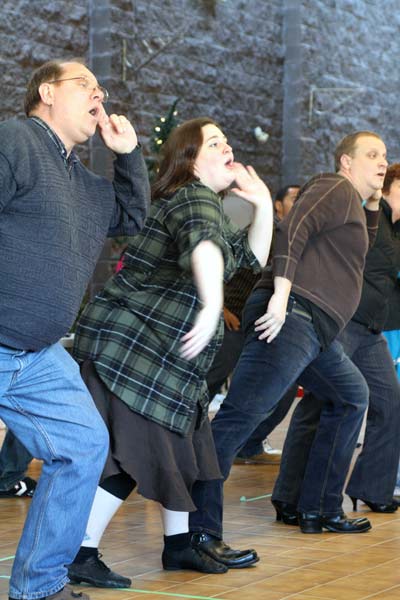
Jennifer Campbell joins her fellow actors in one of the plays many choreographed dane routines. (Katie Lawrence photo)
While her weekdays are filled with homework and studying, Jennifer Campbell’s weekends consist of slapstick comedy, merry songs and the eternal struggle of good versus evil.
Such is the life of an actor.
Campbell, the KSA director for Langley campus, has had a love of acting since Grade 1, and is currently rehearsing for a production of Robin Hood.
The familiar tale is of the cunning Robin Hood who steals from the rich and gives to the poor, thus foiling the plots of the wicked Sherrif of Nottingham and winning the hand of fair Maid Marian.
The play is in pantomime form, which, contrary to popular belief, includes quite a bit of talking and even singing.
“It’s very loud. There’s a whole lot of audience participation,†said Campbell.
She explained that pantomime, or “panto†as it is commonly known, is a specific style of theatre with several reoccurring elements.
A woman always plays the lead male role in a panto, and the play also features dames: men dressed up as women.
“It’s supposed to be like an asexual character, so the dame can make fun of both sexes and it doesn’t matter,†she said.
For Campbell, who is a part of the chorus and plays the girlfriend of Little John, the panto was an opportunity to get back into something she loves.
“I feel more like myself and more confident on stage than I do anywhere else,†she said.
The constant rehearsing since September has created a close group, which Campbell appreciates.
“I think it’s just being onstage and being a part of a family,†she said. “My very first day I was greeted with a hug.â€
Robin Hood runs from Dec. 17 to Jan. 3 at the Surrey Arts Centre and tickets are $24.95 for adults, $19.95 for students and seniors and $12.95 for children under 12.
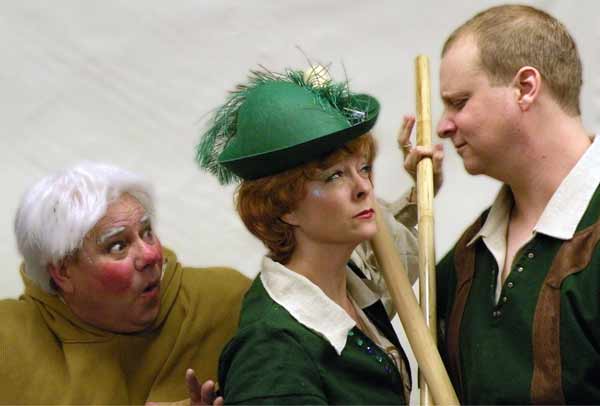
Mandy Tulloch, as Robin Hood, challenges Little John, played by James Knowlden, to a battle. (Photo courtesy of the production)

Frauliene Kibbles, played by Shara Nixon, and Herr Bitz, played by Michael Charrois, express satisfaction about their arrival in Nottingham. (Katie Lawrence Photo)
Video: Kwantlen at belt level
December 2, 2009 by Mitch Thompson · Leave a Comment
Emily Brook is a Kwantlen student who, due to a lifelong disability, relies on a wheelchair for mobility. Here she discusses her disability, as well as the issues of being wheelchair-bound, a state she did not choose but which defines how others see her.



